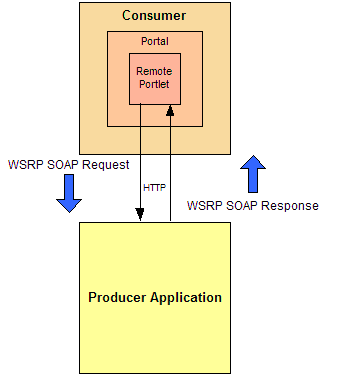







|
Web Services for Remote Portlets (WSRP) is an increasingly popular mechanism used to generate markup fragments on a remote system for display in a local portal application. This section describes how AquaLogic Service Bus can be used to provide Service Level Agreement (SLA) monitoring in applications that use WSRP.
This section discusses the following topics:
WSRP involves two integral components:
This section describes basic WSRP architecture and then shows how this architecture can be enhanced by adding AquaLogic Service Bus.
The following figure shows the basic WSRP SOAP request and response flow between a producer application and a consumer application.

Because a WSRP producer implements SOAP Web Services, an enterprise service bus (such as AquaLogic Service Bus) can be used as an intermediary between the producer and consumer to provide Service Level Agreement (SLA) monitoring, as shown in the following figure.

In this architecture, the WSRP SOAP request/response flow occurs in the following sequence:
The remainder of this section provides instructions for configuring the AquaLogic Service Bus to proxy service requests for WSRP services. It describes services that a producer provides, along with other attributes of WSRP that must be used to properly configure AquaLogic Service Bus. This section also discusses different possible strategies that can be used to monitor producers with increasing degrees of detail. Finally, it discusses load balancing and failover with WSRP.
This topic describes the following WSRP design concepts:
The following table describes the kinds of services offered by producers.
Each producer implements a minimum of two services (Service Description and Markup). A simple producer offers just these two services. A complex producer, however, provides two additional services (Registration and Management). WebLogic Portal producers also implement an extension service (Markup Extension) that replaces the standard Markup service.
These services are described using a standard WSDL format. The producer supplies a single URL for retrieving its WSDL, which describes all of the services that are available from that producer. The end points for each service indicate whether the consumer should use transport-level security (HTTPS) or not to communicate with the producer.
WSRP uses SOAP over HTTP for all messages sent between producers and consumers. In addition to using standard message formats in the SOAP Body, WSRP requires that certain transport headers be set in the request message—at a minimum, consumers must set the SOAPAction header, cookie headers, and the usual HTTP headers (such as Content-Type). Producers will return a session cookie, plus any application-specific cookies, in the HTTP transport header of the response message. The consumer must return the session cookie in subsequent request messages.


|